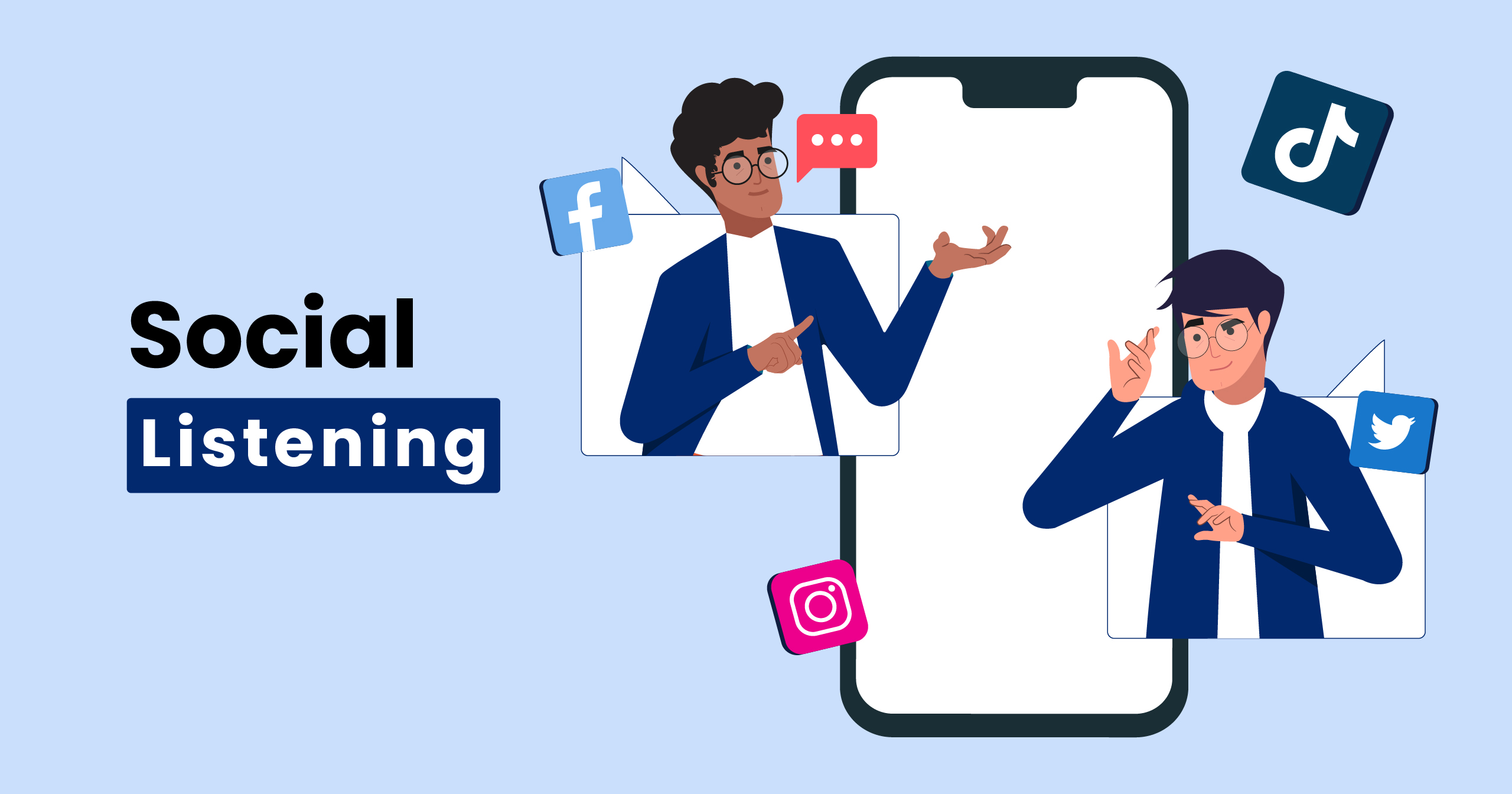In the bustling world of startups, where every decision is a stepping stone to success, social listening emerges as a game-changing strategy.
Imagine having a virtual ear to the ground, capturing real-time conversations about your brand, industry, and competitors. Sounds handy, doesn’t it?
In fact, for startups, social listening isn’t just another marketing option; it’s a powerful tool that can steer your growth trajectory, even if you have limited resources.
It will allow you to tap into the collective wisdom of online conversations to fine-tune strategies, refine offerings, and anticipate market shifts. So, let’s explore how you can turn it into your startup’s secret weapon!
What Is Social Listening?
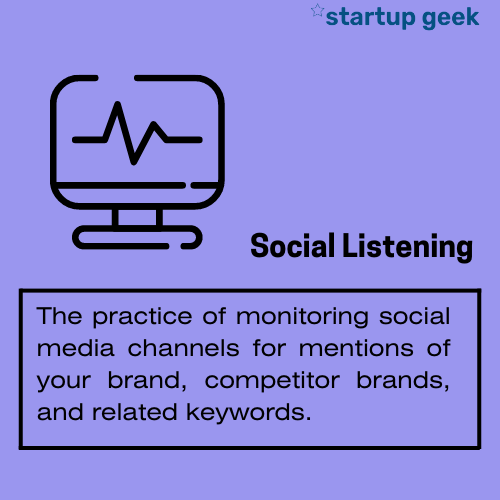
Social listening refers to actively monitoring various social media platforms for mentions of your brand, competitor brands, and relevant keywords.
By keeping a keen ear to the digital ground, you can promptly track every reference to your brand, gaining real-time insights into how customers perceive your products or services.
Furthermore, social listening isn’t limited to merely tracking brand mentions; it extends to monitoring competitors, trending content, and sentiment analysis related to your business.
This offers you a wealth of intelligence that can drive your marketing strategies, product development, customer support, and overall business decision-making, all rooted in data-driven wisdom.
Social Listening Vs. Social Monitoring
As startup founders, it’s essential to recognize the distinction between social listening and social monitoring, as they hold different potentials for your business’s growth.
- Social monitoring is a reactive approach, focusing on specific brand mentions and triggering alerts whenever your brand is discussed online. It proves useful for promptly addressing negative sentiment or customer complaints. However, it offers only a limited perspective on what the online landscape holds for your brand.
- Social listening embodies a proactive and more comprehensive methodology. By encompassing all online conversations relevant to your brand, products, industry, and competitors, it provides a holistic view that aids in making well-informed decisions.
While social monitoring deals with isolated instances, social listening paints the entire picture. For startup success, choosing social listening over monitoring means staying attuned to trends, sentiments, and opinions, thus positioning your business for insightful and strategic growth.
Social Monitoring Example
Imagine you’re the founder of a new fitness tech startup, and you’ve recently launched a smart fitness tracker. With a social monitoring approach, you set up alerts to notify you whenever your brand name or product is mentioned online.
One day, you receive an alert about a negative tweet from a customer who’s experiencing syncing issues with your fitness tracker. With social monitoring, you can quickly respond to the tweet, offer assistance, and address the customer’s concern, which helps in managing the immediate issue.
Social Listening Example
Now, let’s consider the same fitness tech startup using a social listening approach. Instead of just reacting to isolated incidents, you’re actively gathering insights from a wide range of online conversations.
By employing social listening tools, you discover a consistent trend across multiple platforms where users are discussing their desire for a fitness tracker that seamlessly integrates with nutrition apps. This indicates a growing market demand for an integrated health and wellness ecosystem.
Armed with this knowledge, you can now develop a strategic plan to enhance your fitness tracker’s features, focusing on integration with popular nutrition apps. This proactive approach not only addresses the needs of your existing customers but also positions your startup as a leader in the fitness tech industry by catering to broader trends.
The Verdict
In the above examples, the social monitoring approach helped with immediate issue resolution, while the social listening approach provided strategic insights for long-term growth and innovation.
As a startup founder, choosing social listening empowers you to navigate the complexities of the digital landscape, identify emerging trends, and make informed decisions that align with your business goals.
What Are The Benefits Of Social Listening – And How Can You Use It?
Here’s a quick overview of just some of the many benefits of social listening. These will also give you some ideas as to how you can use social listening to your advantage.
Holistic Audience Understanding
Social media listening acts as a precision lens, shedding light on your audience’s authentic desires regarding your brand. It captures diverse scenarios, from existing customers expressing their love for your offerings to conversations where they seek solutions aligned with your capabilities.
These engagements metamorphose into tangible feedback, empowering you to refine products, services, and strategies for elevated customer satisfaction.
- For example, a skincare brand might discover customers discussing their desire for eco-friendly packaging, prompting them to adapt their product packaging strategy to align with customer values.
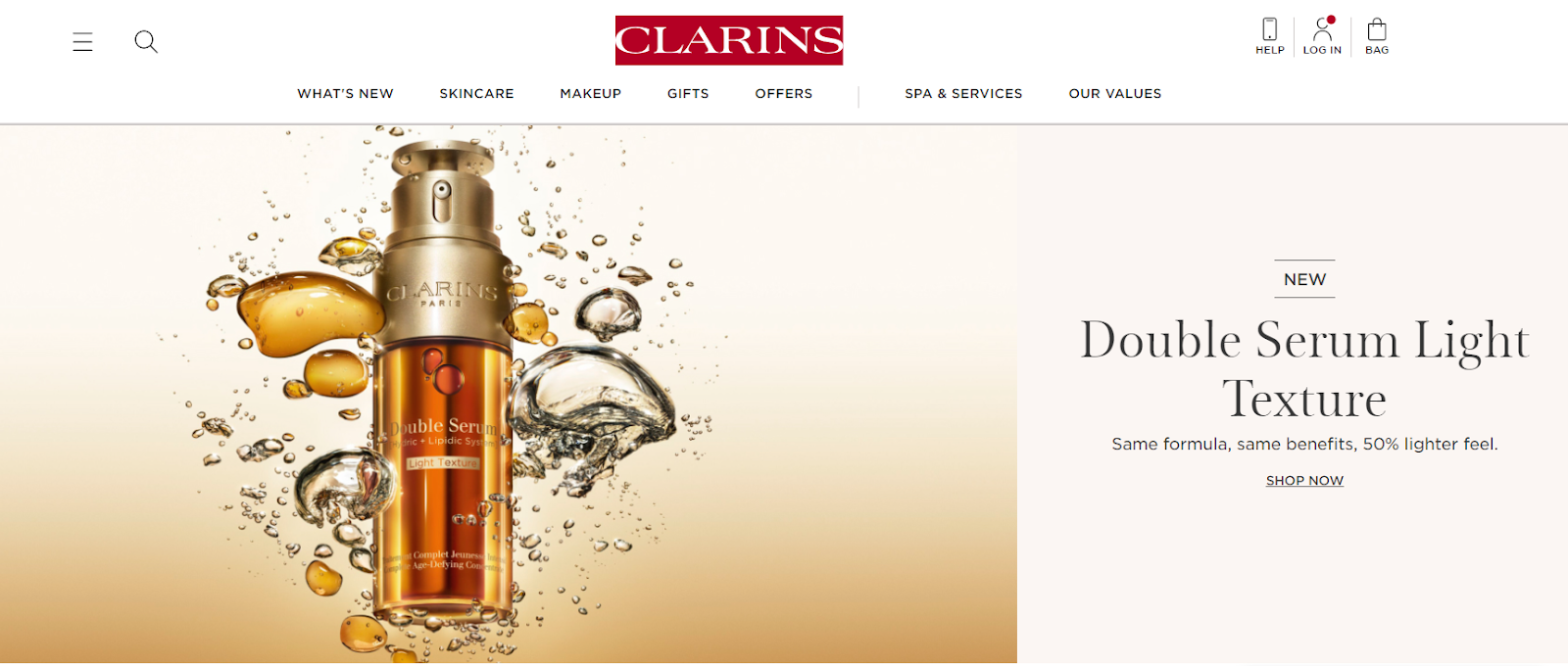
Clarins, for example, learned that their audience is becoming less interested in makeup and more interested in skincare during the pandemic. (Source)
Trend Identification
By actively monitoring conversations, you can unearth emerging trends within your industry and amongst your audience. This invaluable insight enables you to align your offerings with evolving demands, fostering adaptability and innovation.
- For example, a fashion retailer could identify discussions around sustainable fashion and use this trend to guide their product development and marketing efforts.
Responsive Issue Resolution
With social listening, you gain real-time awareness of any emerging negative sentiment or customer complaints. This enables you to respond promptly, mitigating issues before they escalate and demonstrating your dedication to customer welfare.
- For instance, an airline company could detect complaints about flight delays and respond proactively to provide explanations and solutions, thereby enhancing customer satisfaction.

Southwest, for example, uses social media listening tools to differentiate between negative and positive tweets and posts, and act on the former ASAP. (Source)
Competitor Insights
Social listening extends its reach beyond your brand, providing valuable insights into competitor activities, customer perceptions, and industry trends. This intelligence equips you to fine-tune your positioning, differentiate your offerings, and seize market opportunities.
- For example, a technology startup could analyze customer feedback about a competitor’s product to identify gaps and strengths in their own offering.
Strategic Decision-Making
Beyond isolated instances, social listening paints a comprehensive picture of your brand’s online narrative. Armed with this understanding, you can make well-informed decisions that resonate with your audience’s sentiments, leading to more effective marketing campaigns, product launches, and overall business strategies.
- For instance, a restaurant chain could use social listening insights to tailor its menu offerings and promotional campaigns based on customer preferences.
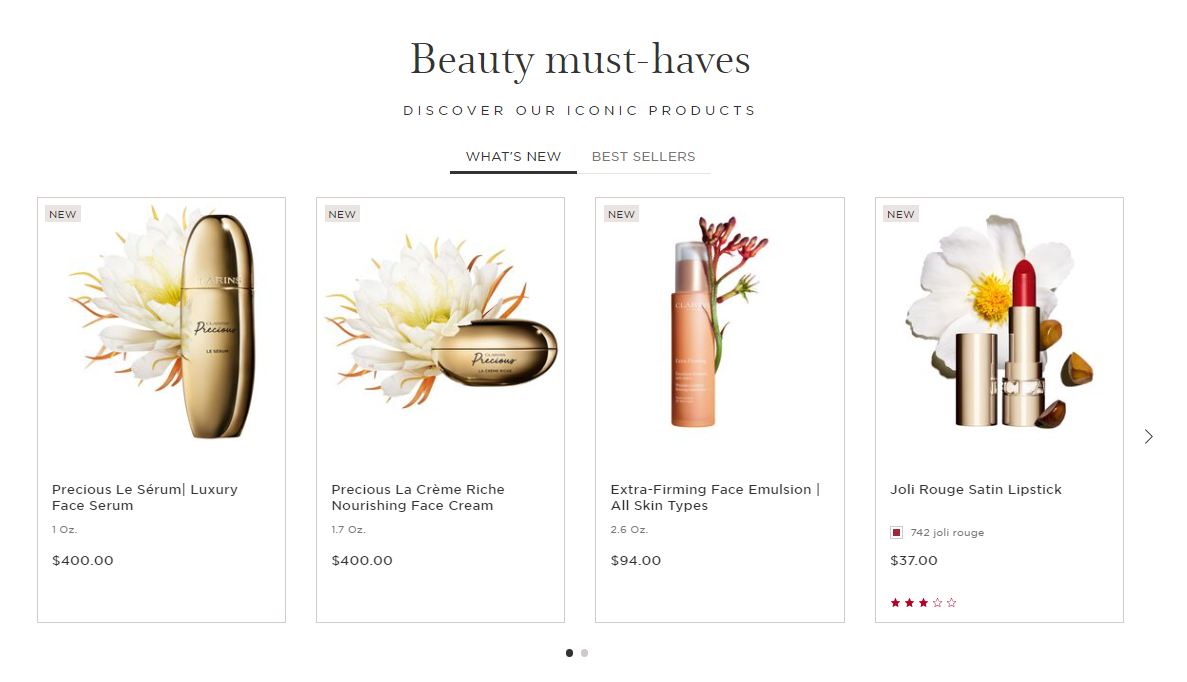
As mentioned, Clarins learned that customers are becoming more interested in skincare than in makeup, so they decided to put more emphasis on that line of products.
Cultivating Brand Loyalty
Drawing from the practices of successful brands that engage with customers proactively on social media, social listening becomes a vital strategy for building brand loyalty. By promptly addressing user inquiries, sharing valuable insights, and providing solutions, you can foster strong customer allegiance, ultimately boosting customer retention and advocacy.
- For instance, a cosmetics brand could respond to a customer’s query about a specific product, providing personalized usage tips.
Enhanced Product Development
Engaging in conversations and collecting feedback through social listening provides a direct avenue to source ideas for new features, products, or services. This collaborative approach ensures that your offerings are tailored to meet genuine customer needs.
- For example, an electronics company might identify customer requests for certain features in their devices, leading to the development of a more user-centric product line.
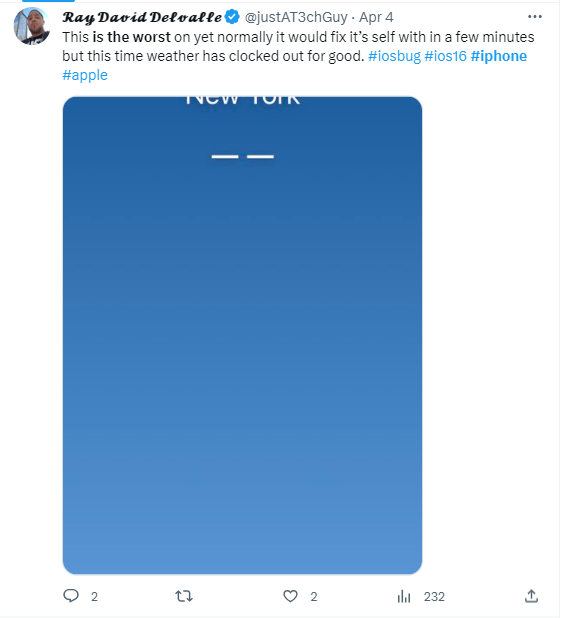
Apple could, for example, track tweets to discover and fix bugs on iPhones. (Source)
In sum, social listening serves as your startup’s navigational compass, guiding you through the labyrinthine realm of customer preferences, industry dynamics, and competitor landscapes. By incorporating this strategy, you harness the collective wisdom of voices across the digital spectrum, propelling your business toward unparalleled success while leaving no facet of excellence unexplored.
Getting Started with Social Listening (In 5 Steps)
Initiating a successful social listening strategy requires a systematic approach. In the following sections, we will outline a comprehensive five-step process you can follow to get started with your own social media listening endeavors!
1. Picking the Perfect Social Listening Tool
Social listening tools will enable your marketing or customer service team to easily monitor conversations pertinent to your business, products, or industry across the social media channels you utilize.
These tools facilitate proactive engagement, regardless of direct mentions. Many platforms offer a unified inbox, streamlining monitoring across channels and ensuring prompt responses to direct mentions, thereby amplifying customer support.
We’ll mention 7 of the currently most popular social listening tools.
1. HubSpot
HubSpot’s social media management software is an all-inclusive tool that gives you an oversight of social interactions with contacts in your database. It facilitates crafting custom keyword monitoring streams and triggers email alerts for timely notifications on mentions.
Additionally, HubSpot facilitates the creation of marketing campaigns and the seamless sharing of relevant content with your target audience.
2. Sprout Social
Sprout Social provides a suite of social media management tools that can help you enhance interactions with customers and prospects.
Noteworthy social listening features encompass a Twitter Listener dashboard for analyzing your Twitter presence, real-time brand monitoring to track direct mentions and brand-relevant keywords, and advanced social listening to unveil emerging trends and influencers.
But Sprout Social also extends its scope beyond Twitter and lets you track direct mentions and brand-relevant keywords across various social channels. The platform’s advanced social listening tools unveil emerging trends and influencers, allowing you to stay ahead of industry shifts and engage with relevant voices.
3. Digimind
Distinguished as a formidable social listening tool, Digimind excels in brand and market monitoring. Its robust features empower businesses to make informed decisions.
With advanced sentiment analysis and real-time exhaustive monitoring across 20+ media types including Facebook, Instagram, TikTok, and Twitter, Digimind provides actionable insights. Customizable dashboards and intuitive reporting make it an excellent choice for startup founders that want a powerful solution.
4. Hootsuite
Hootsuite’s comprehensive social media marketing and management dashboard aids in cultivating relationships with your social media followers.
Hootsuite allows you to create Customizable Streams, which further lets you curate and display content that is directly relevant to your goals. Whether you’re monitoring brand mentions, tracking competitor activity, staying updated on industry trends, or engaging with customer interactions, this customizable approach enables focused and efficient monitoring.
Hootsuite also enables Scheduled Monitoring, which automates the process of staying updated on conversations even during periods of inactivity.
5. Talkwalker
Talkwalker offers robust social listening software features that analyze blogs, forums, videos, news sites, review sites, and social networks in one dashboard, drawing data from over 150 million sources.
Advanced filters allow for data segmentation, focusing on key messages and audiences. Alerts can be set up for spikes in mentions or keywords.
6. Synthesio
Synthesio, a social media listening tool, tracks conversations on specific topics within segmented audiences. It enables data segmentation by language, location, demographics, sentiment, gender, influence, and more.
The reports include a useful social reputation score, offering insights about your performance relative to competitors.
7. Mentionlytics
Mentionlytics tracks mentions, keywords, and sentiment across multiple languages across social platforms, blogs, and news sites. Integrated with Hootsuite, you can view them on your dashboard.
Mentionlytics facilitates locating influencers, tracking keywords in different languages, and even detecting emotions in each mention.
2. Define Your Desired Goals and Outcomes
Addressing the ultimate question — What do you hope to achieve through social listening? — will help direct your strategy. Here are some of the most common objectives for brands.
- Thorough Brand Analysis: Delving into customers’ and prospects’ perceptions of your brand.
- Industry Insight: Keeping a finger on the pulse of your industry or niche by staying informed about emerging trends and potential content ideas.
- Competitor Surveillance: Monitoring your competitors’ products, target audiences, and marketing approaches to shape your own strategies.
- Content Direction: Leveraging trends and data to determine the type of content to share, aligning with audience interests.
- Audience Understanding: Identifying and understanding your key social media audience segments, honing your targeting strategy.
You can also ask yourself the following questions to define your goals and desired outcomes:
- Are you about to launch a product and want to gauge interest levels?
- Do you want to engage and better connect with existing customers?
- Are you aiming for a comprehensive view of your competition, understanding how you stand among rivals?
- Is identifying key competitors to your business crucial for you?
- Are you striving to optimize your offers based on customer feedback?
- Do you wonder if people are even having discussions about your brand or exploring ways to amplify awareness?
Answer these questions and take it from there!
3. Select The Right Data Sources
When it comes to social listening, a crucial decision revolves around where to gather your data. So, where should you pull your listening data from?
To determine this, you should know where and how your audience engages in discussions.
Conversations about your brand or industry on LinkedIn, for example, might differ significantly from those on Twitter, Instagram, or Facebook. It’s also possible that your brand is frequently discussed on one platform but rarely mentioned on another.
Gaining insight into where discussions about your brand and industry take place and how they differ across platforms is essential.
- However, if you don’t yet know your audience’s preferred conversation hub, you may want to consider covering a variety of platforms until you find the perfect match.
- Alternatively, you can start with Twitter — the prime data source for many social listening tools. Instagram and Facebook also offer viable options for data collection.
4. Find Your Keywords, Themes, And Topics
It’s time to build your topics, themes, and keywords. This critical step lays the foundation for a successful approach to understanding conversations across the digital landscape.
To effectively define your listening topics, consider brainstorming specific queries that align with your brand’s objectives. This involves identifying terms you want to actively listen for, as well as discerning noise that you should avoid to ensure accurate results.
- Keywords: Core terms that directly relate to your brand, products, or industry.
- If you’re a coffee shop, keywords could include “artisanal coffee,” “coffee beans,” and “coffeehouse experience.”
- Hashtags: Relevant hashtags that amplify discussions about your topics of interest.
- For a fitness brand, relevant hashtags might be “#FitnessJourney,” “#HealthyLiving,” “#WorkoutMotivation.”
- Mentions of Users: Tracking conversations involving specific users or influencers.
- Suppose you’re a fashion brand collaborating with an influencer. In that case, you could track conversations mentioning “@InfluencerUsername.”
- Suppose you’re a fashion brand collaborating with an influencer. In that case, you could track conversations mentioning “@InfluencerUsername.”
- Mentions from Users: Identifying content where users directly mention your brand.
- Identifying content where users mention “@YourBrand” indicates direct engagement.
Expanding beyond hashtags and keywords, you can enhance your search precision with “and/or logic.” This involves refining your search queries further by incorporating additional parameters.
Let’s say you’re a fitness apparel brand. You want to gather insights about discussions related to your brand’s athletic wear, but you also want to filter out any noise related to general sports equipment.
To achieve this, you can employ both “and/or logic” and exclusions:
“athletic wear” OR “activewear” AND NOT “sports equipment” OR “sports gear”
By using “and/or logic,” you’re encompassing different terms that people might use to talk about your products. Additionally, the exclusion of “sports equipment” ensures that your search remains focused specifically on the type of clothing your brand offers.
This strategic combination helps you target discussions that are directly relevant to your brand while filtering out unrelated noise.
Pro tip: To refine your social listening strategy, start by compiling a list of keywords specifically associated with your brand and products and with your industry. This dual approach ensures comprehensive coverage, enabling you to not only monitor your brand but also gain insights into competitor activity and industry trends.
5. Gather And Analyze Your Data
Now that you’ve laid the groundwork for your social listening strategy, it’s time to roll up your sleeves and gather the insights that will steer your startup toward success.
- Create a Comprehensive Spreadsheet: Begin by organizing your findings in a structured spreadsheet. Each comment, mention, or review deserves a place, categorized based on its nature and sentiment.
- Establish Clear Guidelines: Outline how you’ll handle different types of findings. Determine the course of action for improving negative comments, showcasing support for positive reviews, responding to competitors’ mentions, and addressing negative sentiments about them.
- Navigate the Competitor Landscape: When your competitors are praised, respond gracefully. If negative comments arise about them, tread carefully.
- Monitor High-Performing Content: Keep an eagle eye on the content and keywords that resonate most with your audience. Identify patterns in what they engage with, new followers gained through specific keywords and topics that fuel interaction.
- Measure and Adjust: Track metrics aligned with your campaign goals, such as clicks, reach, new followers, engagement rates, and profile visits. Let these metrics guide your strategy adjustments.
- Iterate for Success: Use the data you’ve collected to iterate on your social listening strategy. Regularly refine your approach, tweaking keywords, responses, and content to align better with your audience’s preferences.
Case Studies: 4 Companies Using Social Listening To Their Advantage
Let’s delve into the experiences of four distinct companies that have harnessed the potential of social listening to not only address challenges but also achieve remarkable outcomes.
From global transportation giants to healthcare brands and sports franchises, these case studies exemplify how strategic integration of social listening can lead to tangible growth, deeper customer connections, and more informed decision-making.
1. Uber
Uber, the global transportation network company, has released their new rider app. With it, they also used a strategy that perfectly exemplifies the potential of social listening.
As Uber introduced modifications to their app, they keenly observed user reactions. This approach enabled them to gauge enthusiasm and identify areas that needed further refinement.
By employing a social listening tool, Uber was able to gather real-time feedback, comprehend user preferences, and optimize their product effectively.
The results were remarkable.
- Within just two days of the new app’s rollout, online discussions about Uber surged by 100%.
- Engagement metrics soared, with likes increasing by 90% and shares skyrocketing by 250% compared to previous levels.
Uber’s experience exemplifies how social listening can unveil actionable insights that drive product development, enhance customer satisfaction, and ultimately increase online exposure. By leveraging the power of social listening, companies like Uber are turning conversations into invaluable data points, steering them toward innovation and success.
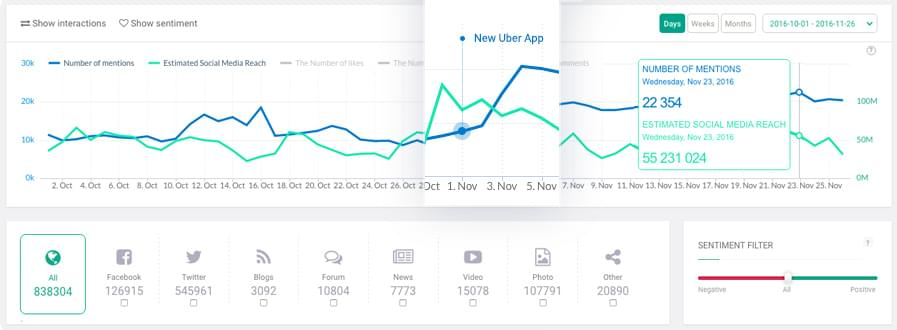
Uber was immediately able to see the increase in the number of online discussions about their brand after rolling out their new rider app. (Source: Brand24)
Summary
- Goals: Leveraging social listening to gather real-time user feedback and optimize app modifications.
- Obstacles: Managing user reactions to app changes and refining the user experience.
- Results: Uber’s use of social listening may have led to a 100% surge in online discussions and significant increases in engagement, namely likes and shares.
2. Tylenol
Tylenol, a trusted brand synonymous with pain relief, has maintained its relevance by adapting to changing health landscapes. However, as the spectrum of pain evolved, Tylenol recognized the need to stay attuned to the shifting patterns.
This led them to turn to attentive social media listening.
Their objective wasn’t just to stay relevant, but also to gain a better understanding of the dynamic realm of pain and its triggers.
By actively tuning into online conversations, Tylenol unearthed a fascinating trend. It became evident that individuals engrossed in hobbies demanding intense focus were increasingly reporting symptoms associated with migraines.
Among these hobbyists, knitters emerged as unexpected protagonists, shedding light on the intricate connection between their passion and migraines triggered by eye strain.
Armed with these insightful revelations, Tylenol’s strategy underwent a strategic transformation. Departing from a generic marketing approach, the brand pivoted towards a tailored strategy.
They curated content tailored to resonate with knitters and those immersed in activities requiring intense concentration. This shift led to a meaningful resonance with the identified segment, culminating in heightened engagement and a substantial surge in website traffic.
Tylenol’s journey demonstrates how social listening can help uncover uncharted growth opportunities, but also how brands can drive customer loyalty by going beyond conventional marketing.
Summary:
- Goals: Using social listening to adapt to evolving pain relief market trends and understand customer needs.
- Obstacles: Staying relevant in a changing pain relief landscape and comprehending shifting customer preferences.
- Results: Tylenol’s social listening strategy revealed a connection between intense hobbies and migraines, leading to tailored marketing and increased engagement.
3. RingBoost
RingBoost, a leading custom phone number marketplace, embarked on a transformative quest for growth and deeper customer connections. Ellen Sluder, VP of Marketing, illuminated how this journey reshaped RingBoost’s trajectory.
While renowned for delivering cost-effective marketing assets that boost brand recognition and loyalty, RingBoost faced the challenge of staying attuned to evolving market trends, seamless customer engagement, and swift feedback management.
They turned to Awario, a platform delivering real-time social insights and promising to empower RingBoost’s responsiveness. Objectives were clear: monitor brand mentions, track competitors, and glean insights from industry leaders.
Awario equipped RingBoost with real-time insights that helped the company transform audience engagement. Prompt, personalized responses fortified relationships, enhancing the brand’s digital footprint.
- Awario’s customization filtered data and helped RingBoost create informed strategies.
- The outcomes were palpable—reduced response times heightened customer satisfaction, while streamlined workflows allocated resources for innovation.
- Competitive tracking adeptly navigated changing landscapes, revealing trends and strengthening their value proposition.
- RingBoost also used Awario to extend to platforms like Reddit and seize untapped market niches.
RingBoost’s journey embodies adaptability, satisfaction, prioritization, and innovation. This venture paves the way for elevated engagement, strategic innovation, and scaling new heights in modern business.
Summary
- Goals: Enhancing customer connections and fostering growth through social media listening.
- Obstacles: Navigating changing market trends, customer engagement, and feedback management.
- Results: Reduced response times, enhanced engagement, and uncovering untapped market niches.
4. Atlanta Hawks
Navigating the intricacies of fan engagement and corporate partnerships isn’t an easy feat, but the Atlanta Hawks executed it with finesse through their collaboration with Sprout Social.
Katie DuPre’, the Social Strategy Manager at the Atlanta Hawks, understood the challenges of staying relevant in a dynamic digital landscape while meeting the needs of diverse stakeholders. Their goal was to harmonize their brand story with their city’s narrative.
Leveraging Sprout’s Tagging feature, DuPre’ and her team strategically categorized content to cater to evolving audience preferences. This approach allowed them to craft tailored content that resonated with various segments.
Overcoming the hurdle of managing over 35 corporate partners, DuPre’ embraced Sprout’s A/B testing functionality. This empowered the team to experiment with new content formats and gather actionable insights. Their ability to transparently share performance data bolstered partner trust and collaboration.
Yet, the Hawks knew that metrics weren’t the sole measure of success. Sprout’s Social Listening tool played a pivotal role in augmenting their strategy. By diving into audience sentiments and capturing real-time insights, they were able to refine their content, driving deeper connections with fans and partners alike.
The outcome? The Atlanta Hawks achieved an impressive 170.1% audience growth on Facebook and a notable 127.1% surge in video views from December ‘21 to February ‘22.
But beyond the numbers, they cultivated a strategy that aligned their brand, city, and audience, proving that data-driven insights coupled with thoughtful execution can score big wins on and off the court.

Atlanta Hawks’ results may be, at least partially, attributed to social media listening. (Source: Sprout Social)
Summary
- Goals: Balancing fan engagement, corporate partnerships, and brand-city alignment through social media collaboration.
- Obstacles: Staying relevant in a dynamic digital landscape, managing corporate relationships, and creating deeper fan connections.
- Results: A 170.1% audience growth on Facebook and a 127.1% surge in video views.
FAQs
Which social media channels or platforms can I track with social listening tools?
It will depend on the social listening tool you’re using but, generally speaking, you can track anything! You can track your desired topics on Google, a specific social media platform, blog, or forum – or literally anywhere on the web!
What can I track?
You can track anything and everything. It will depend on the information you’re looking for and the things you want to find out. Marketers know that everything starts with a good understanding of your target consumer, brand, and others in your industry – yes, your competitors. So, make sure to consider this as well as your reasons for social media listening in the first place. What difference or impact are you hoping it will make?
What can’t I track using social listening?
With social listening, you can’t track private conversations, offline interactions, or accurately gauge complex sentiments. In-depth customer feedback and predicting future trends are also beyond its scope.
While it provides insights, it might not offer precise demographic data. Remember, it complements, but doesn’t replace other methods of audience research.
How can I find the right topics to track?
Everything starts with research. You can research a particular topic or keyword connected to your brand or industry and get more ideas that way. You could also look at your competitors’ posts and messaging to get some additional ideas! Monitor your analytics after implementing social media listening and let them inform your future strategy. It’s OK not to get it right on your first try.
Can social listening also help me drive more sales?
Yes, social listening can also help you drive more sales. This should be a natural result of all of the other benefits of this marketing strategy.
What are some best tips for social listening?
Effective social listening begins with clear objectives and a well-suited tool. Also, you should choose precise keywords and hashtags, and remember to keep an eye on your competitors.
Wrapping Up
As startup founders, your journey is uniquely challenging, but social listening offers an essential advantage. By actively listening to the digital chatter, you gain insights that fuel strategic decisions.
From understanding audience preferences to aligning with industry trends, social listening shapes your startup’s growth story. The digital realm is rich with voices waiting to provide invaluable feedback.
By harnessing these insights, you can create exceptional customer experiences, foster unwavering brand loyalty, and cultivate innovations that resonate deeply. So, embrace the power of social listening as your compass, and navigate your startup to success, leaving no opportunity untapped.
